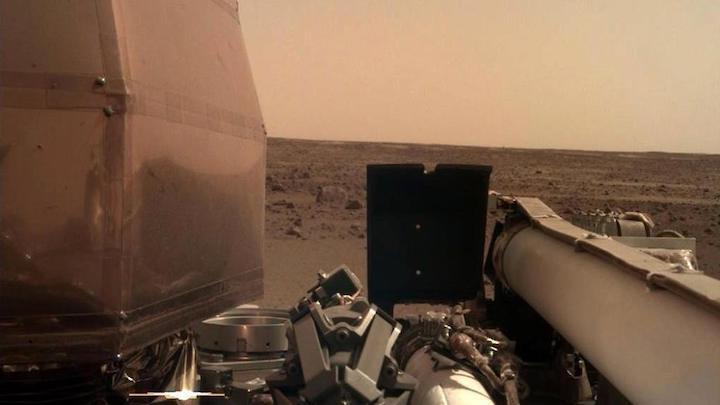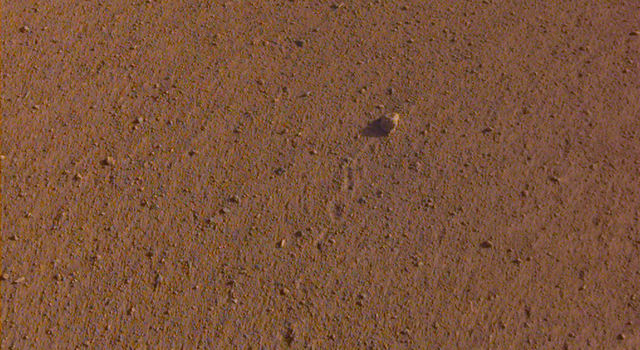23.08.2019

There is now a "Rolling Stones Rock" on Mars, and it's giving Mick, Keith and the boys some serious satisfaction.
NASA named a little stone for the legendary rockers after its InSight robotic lander captured it rolling across the surface of Mars last year, and the new moniker was made public at Thursday night's Rolling Stones' concert at the Rose Bowl.
"NASA has given us something we have always dreamed of, our very own rock on Mars. I can't believe it," Mick Jagger told the crowd after grooving through a rendition of "Tumbling Dice." ''I want to bring it back and put it on our mantelpiece."
Robert Downey Jr. announced the name, taking the stage just before the band's set at the Southern California stadium that is just a stone's throw from NASA's Jet Propulsion Laboratory, which manages InSight.
"Cross-pollinating science and a legendary rock band is always a good thing," the "Iron Man" actor said backstage.
He told the crowd that JPL scientists had come up with the name "in a fit of fandom and clever association."
"Charlie, Ronnie, Keith and Mick — they were in no way opposed to the notion," Downey said, "but in typical egalitarian fashion, they suggested I assist in procuring 60,000 votes to make it official, so that's my mission."
He led the audience in a shout of "aye" before declaring the deed done.
Jagger later said, "I want to say a special thanks to our favorite action man Robert Downey Jr. That was a very nice intro he gave."
The rock, just a little bigger than a golf ball, was moved by InSight's own thrusters as the robotic lander touched down on Mars on Nov. 26.
It only moved about 3 feet (0.9 meters), but that's the farthest NASA has seen a rock roll while landing a craft on another planet.
"I've seen a lot of Mars rocks over my career," Matt Golombek, a JPL geologist who has helped NASA land all its Mars missions since 1997, said in a statement. "This one probably won't be in a lot of scientific papers, but it's definitely one of the coolest."
The Rolling Stones and NASA logos were shown side by side in the run-up to the show as the sun set over the Rose Bowl, leaving many fans perplexed as to what the connection was before it was announced.
The concert had originally been scheduled for spring, before the Stones postponed their No Filter North American tour because Jagger had heart surgery.
The 76-year-old showed no signs of poor health or even his age as he danced, pranced and boogied up and down a long catwalk that extended to the middle of the stadium's field.
He did poke fun at his advanced years.
"It's great to be back at the Rose Bowl in Pasadena," Jagger said. "At least I think we've been here before." (They have, in 1994.)
He also said, "We walked up and down Hollywood Boulevard looking for the Rolling Stones star but couldn't find it." (The band doesn't have one.)
And he took a dig at President Donald Trump's recent talk of acquiring Greenland when introducing his bandmates.
"On the drums," Jagger shouted, "Greenland's new economic adviser, Charlie Watts!"
Quelle: abcNews
+++
NASA-JPL Names 'Rolling Stones Rock' on Mars
› Larger view
More photos and videos as they become available: https://go.nasa.gov/MarsRocks
For decades, the music of The Rolling Stones has had a global reach here on Earth. Now, the band's influence extends all the way to Mars. The team behind NASA's InSight lander has named a Martian rock after the band: 'Rolling Stones Rock.'
The Rolling Stones - Mick Jagger, Keith Richards, Charlie Watts and Ronnie Wood - were delighted with the news and commented, "What a wonderful way to celebrate the 'Stones No Filter' tour arriving in Pasadena. This is definitely a milestone in our long and eventful history. A huge thank you to everyone at NASA for making it happen."
A little larger than a golf ball, the rock appeared to have rolled about 3 feet (1 meter) on Nov. 26, 2018, propelled by InSight's thrusters as the spacecraft touched down on Mars to study the Red Planet's deep interior. In images taken by InSight the next day, several divots in the orange-red soil can be seen trailing Rolling Stones Rock. It's the farthest NASA has seen a rock roll while landing a spacecraft on another planet.
The team behind NASA's InSight lander has informally named a rock on Mars "Rolling Stones Rock" after the band. .
"The name Rolling Stones Rock is a perfect fit," said Lori Glaze, director of NASA's Planetary Science Division in Washington. "Part of NASA's charter is to share our work with different audiences. When we found out the Stones would be in Pasadena, honoring them seemed like a fun way to reach fans all over the world."
Actor Robert Downey Jr. made the announcement Thursday, Aug. 22 at Pasadena's Rose Bowl Stadium before the iconic band took the stage. Backstage before making the announcement, Downey said, "Cross-pollinating science and a legendary rock band is always a good thing..."
Before The Rolling Stones took the stage at the Rose Bowl Stadium for a concert on Aug. 22, 2019, actor Robert Downey Jr. announced to the crowd that a rock on Mars had been named for the band by NASA's Mars InSight lander team. The Jet Propulsion Laboratory (JPL), a division of Caltech, manages InSight for NASA. JPL is located about three miles away from the Rose Bowl in Pasadena, California. Credit: Rolling Stones .
The InSight mission is led by NASA's Jet Propulsion Laboratory, just up the road from the Rose Bowl in Pasadena. Having helped NASA land all of its Mars missions since 1997, JPL geologist Matt Golombek is a rock star in his own right. He and fellow scientists count rocks and assess the safety of potential landing sites.
"I've seen a lot of Mars rocks over my career," Golombek said. "This one probably won't be in a lot of scientific papers, but it's definitely one of the coolest."
Official scientific names for places and objects throughout the solar system - including asteroids, comets and locations on planets - can be designated only by the International Astronomical Union. But scientists working with NASA's Mars rovers have given lots of unofficial nicknames to rocks and other geological features. Doing so makes it easier for them to discuss different objects and refer to them in science papers. So while the name Rolling Stones Rock is informal, it will appear on working maps of the Red Planet.
NASA will use its robotic missions to Mars to help prepare for eventual human exploration of the Red Planet. Charged with returning astronauts to the Moon, NASA's Artemisprogram is the next step in human exploration. It is a part of NASA's broader Moon to Mars exploration approach, which will quickly and sustainably explore the Moon and enable humanity's next giant leap to Mars.
About InSight
JPL manages InSight for NASA's Science Mission Directorate in Washington. InSight is part of NASA's Discovery Program, managed by the agency's Marshall Space Flight Center in Huntsville, Alabama. Lockheed Martin Space in Denver built the InSight spacecraft, including its cruise stage and lander, and supports spacecraft operations for the mission. A number of European partners, including France's Centre National d'Études Spatiales (CNES) and the German Aerospace Center (DLR), support the InSight mission. CNES provided the Seismic Experiment for Interior Structure (SEIS) instrument to NASA, with the principal investigator at Institut de Physique du Globe de Paris (IPGP). Significant contributions for SEIS came from IPGP; the Max Planck Institute for Solar System Research (MPS) in Germany; the Swiss Federal Institute of Technology (ETH Zurich) in Switzerland; Imperial College London and Oxford University in the United Kingdom; and JPL. DLR provided the Heat Flow and Physical Properties Package (HP3) instrument, with significant contributions from the Space Research Center (CBK) of the Polish Academy of Sciences and Astronika in Poland. Spain's Centro de Astrobiología (CAB) supplied the temperature and wind sensors.
Quelle: NASA




